It's September, a month of change and probably my favourite time of year.
Summer is drawing to a close, days are shortening and colours are deepening.
Being my birthday month gives added kudos for me. It's a period when I take time out and time off to reflect on the past nine months after the frenetic blooming of the natural world and now it's subsequent withdrawal, until Spring sparks it into life once more.
Although, as I observe nature as it deals with the Autumn and Winter stasis, it is anything but, just another season in which it tries it's best to survive under different circumstances. Although not procreating and raising families, life for them is just a busy and just as challenging, sometimes even more so.
I am blessed to live, not only in a beautiful part of the UK but a part of the world where there is so much happening every day.
This island is the natural through route for many bird species and September is the prime month to witness their migration. Some are leaving, some are passing through while others in the next few weeks will call this place home, being more temperate than their breeding grounds.
I had arranged to meet my friend Chris on the harbour wall at Titchfield Haven, three miles from our front door for a wander around the area. Our hope was to catch a glimpse of some interesting things along the way. Either way, it was great to get out, watch the world go buy and have a giggle into the bargain. After a challenging month, I needed it.
The weather played right into our hands. Flat calm on the sea with a tide almost at it's lowest ebb. The sun beginning to colour a cloudless sky from the monochrome mist.
This is one of the best times of day. Few people, still conditions and nature at ease, getting on with living.
Out on the shore, Black Tailed Godwits probed the silt for invertebrates with their long bills
As the sun lifted above the horizon it picked them out with it's warm soft light
The path turns northwards towards the village. With the canal on the left, the reserve is on our right, open fields with long grass that can hide all manner of things. Every few yards there's a gate that allows long views across to the reserve where the Meon River snakes it's way through to the Solent.
The summer breeding migrants appeared again. The valley is a great through route for them with plenty of places to stop and feed. This female Redstart doing exactly as Redstarts do, sit in a low bush such as this hawthorn and drop down to feed on any unsuspecting insect below, whilst usually returning to the same perch.
Halfway up the path our eyes were sky gazing hoping for Flycatchers sat on exposed perches. Another species migrating south. No Flycatchers but a Great Spotted Woodpecker this time...
More warblers in the shape of a male Blackcap fed through the undergrowth.
Every time I reach the oak tunnel I have to take a shot...
Yellow Wagtails - another species feeding up on their push southwards. They can often be seen associating with horses or cattle. The animals disturb the ground for the Wagtails to pick up insects or around the faeces the animals drop, weaving in and around their legs
Opposite these on the other side of the canal, several Chiffchaffs and Willow Warblers darted around the bushes picking out insects. More species heading to warmer climes for the coming seasons, although some Chiffchaffs are spending more and more time here as our winters become milder by the year.
They often mix with other species too. Blackcaps, Long Tailed, Blue and Great Tits are not uncommon in one loose flock. There's even a chance of something even rarer such as a Yellow Browed Warbler but sadly not on this day.
We turned and began our walk back to the Haven. We had booked a slot to enter to the reserve and see what was about on the scrapes. Another good chance to see birds dropping in to feed on their migration, most notably, all sorts of waders.
The Chiffys kept showing in the bushes as we neared the reserve
We checked into the visitor centre then headed to the west entrance. We had barely advanced through the gate when we spotted a Peregrine gliding over onto the scrapes. It made a lunge over the hide and down in a fast swoop, then up and away without catching anything. That's all the waders disappeared we thought !
Our trepidation of a barren scene was misplaced. Maybe it was so quick not many birds reacted before it was gone in a flash.
A very common wader is the Redshank. They breed inland generally in the UK but can be seen all year round on the coast. Their numbers swell here in Autumn and Winter. It's not unusual to see them congregate in large numbers.
Now we get into more rarefied territory. Curlew Sandpipers breed in Northern Europe and are seen in small numbers as they migrate south. No more than 700 or so each year. Some years are better than others to see them. This year has been good so far. Several have been seen around the area.
By now, the Green Sandpiper had woken up...
Now we come to probably the most uncommon bird of the day here. A Little Stint. Another that pass through in similar numbers to the Curlew Sandpiper but always seem more scarce and usually seen in single numbers.
Common Sandpiper again, one of at least three.
If you visited North Norfolk in Winter to places such as The Wash, you can witness Knot in huge numbers, especially at their high tide roosts.
The feeding action was all around us with quite a lot of crossover for comparison of the different species.
One wader that can't be confused with anything else, the Lapwing or Peewit. So called from the sound of it's call
Knot once again...
Onto yet another different wader. We were blessed on this Saturday.
Away from the wader action. Some Terns were still hanging around with juveniles to feed but they will soon disperse. This is a Common Tern
Three more Knot flew in but kept away from the one feeding before us.
To give a good size and plumage comparison, the Little Stint on the right sat with a Dunlin on the left on one of the islands..
All the while the Common Sandpiper kept feeding underneath the windows of the hide.
Were there are lots of prey, naturally the predators will follow. Kes is a regular here and has a true Catholic taste. Most commonly associated with hovering, looking for rodents, I've had them hunting birds in my garden and here they will take anything put before them.
In early Spring the earliest bird to arrive on these shores is usually the Wheatear. It's name formed from the white rump it shows in flight or 'White Arse!' These can be one of the last to leave in Autumn
They regularly perch on mounds and posts when hunting insects. Here we found a few around the seawall and on the fields just inland.
Although this looks like a levitating Wheatear it was in fact just in the process of flying off, I caught it just right !
Our hope of seeing the usual Osprey in the usual trees on one of the remote island in Langstone Harbour drew a blank. There are many flight routes the Ospreys' can take as they head over the South Coast. Either here, The Haven or Southampton but this year it seems wherever we are, they are not. I missed one at The Haven the previous week by half and hour. Just not our year it seems.
On the opposite side of the lake Grey Plover congregated. Some 150 birds and some individuals still in their breeding attire which is pleasing to see. Come winter they will be living up to their name.
We decided on a last detour past the lake and towards the stream and back to the information hut where we came in.
The stream came good again in regards to more waders. Nine Curlew Sandpipers had flown in giving as good a view than that at the Haven.
The one in the front looks like an adult with the waning colour on it's breast, whereas the paler bird behind more like a juvenile.
As some took off, it was a good chance to notice the white rump that distinguishes it from the smaller Dunlin.
Great little waders and a pleasure to see again.

























































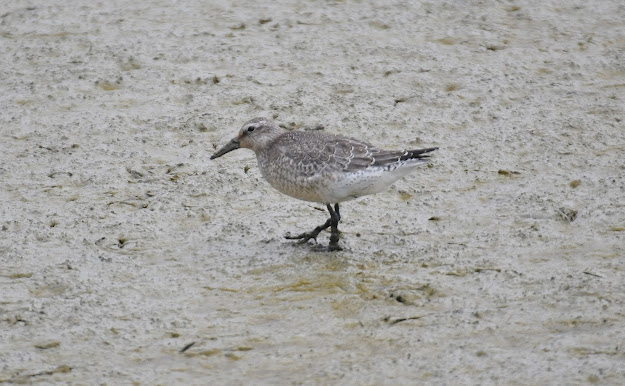





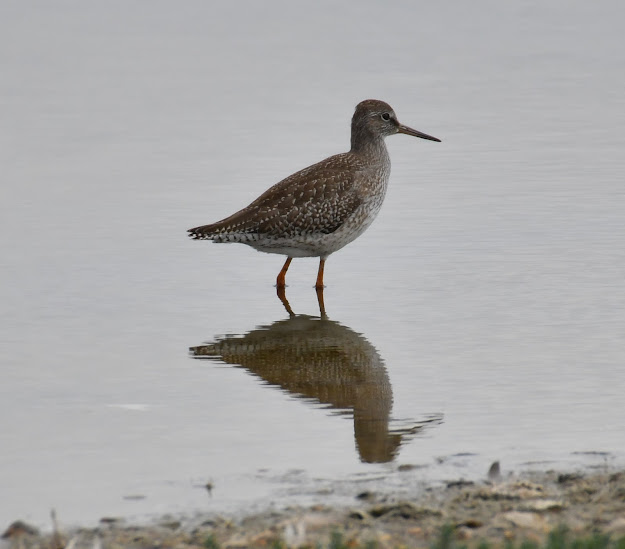








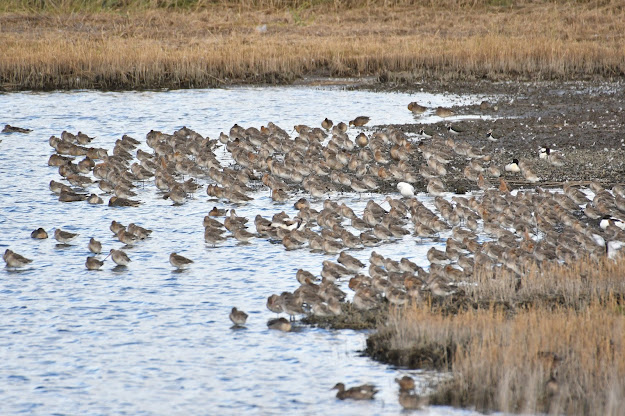


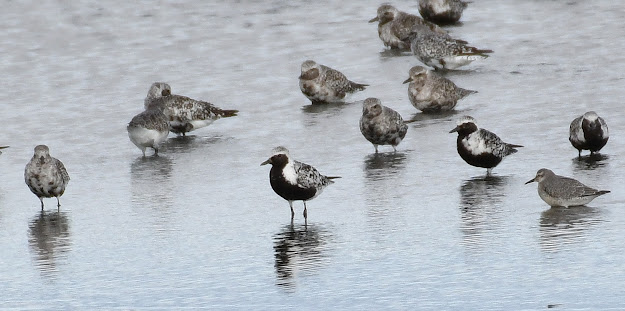

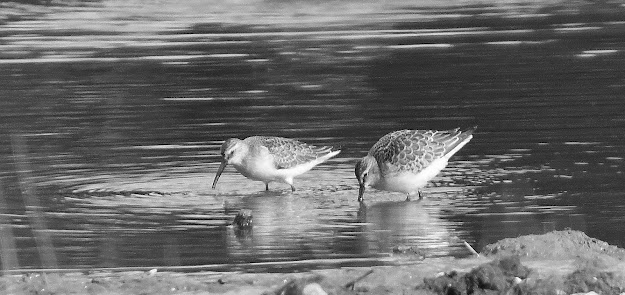




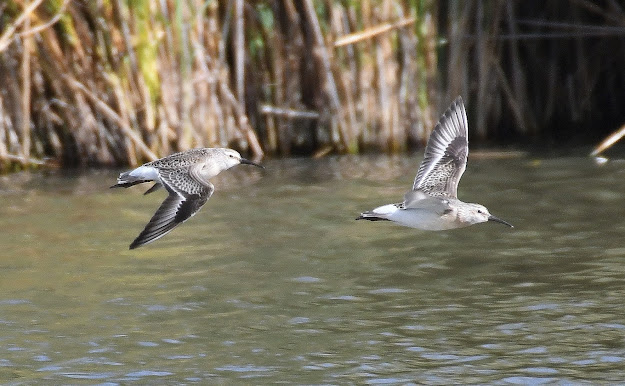

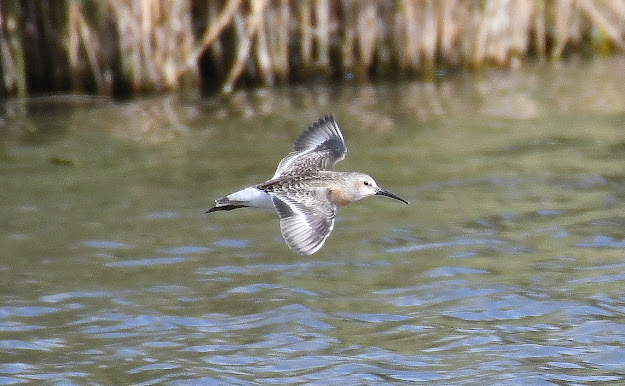


Lovely.
ReplyDeleteThank you !
DeleteWonderful blog Smudger, as always. We saw the Grey Plovers and the Black Tailed Godwits last week when we were at the Marshes. A couple of your photos are exactly the same as mine - only better :-)
ReplyDeleteThank you Jan. We were there Sat, don't tell me we walked past each other ?!
ReplyDelete